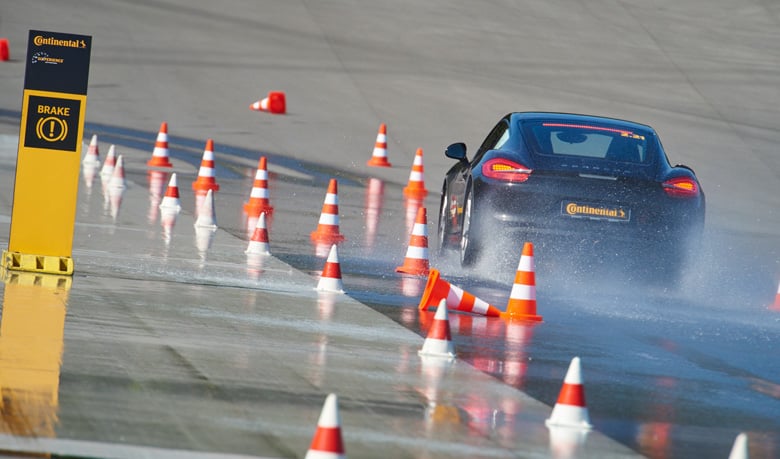October 28, 2019 |
Aquaplaning: Minimum Legal Tread Depth Can Prove Fatal
- AutoBild tests ABS anti-lock brakes in heavy rain
- Braking distance from 120 km/h was almost 100 m longer on worn tyres than on new ones
- Regular tread depth checks are an absolute must
The tread depth determines how much water a tyre can take up and disperse from beneath the contact patch. The less tread you have remaining, the more likely it is that a wedge of water will build up ahead of the tyre. This leads to aquaplaning as the tyre loses contact with the road surface. When aquaplaning occurs, the tyres can no longer transmit steering commands or braking forces to the road and the car drifts out of control.
An in-vehicle test conducted recently by AutoBild revealed just how dramatically the braking distance increased on very wet road surfaces. In the test, a VW Golf was fitted with 225/45 R 17 tyres from Continental, Goodyear and Michelin with different tread depths. The findings were shocking.

The best outcome, braking from 80 km/h with anti-lock brakes, was achieved by the Continental tyre, which in brand-new condition brought the car to a stop in 25.8 meters. With a residual tread depth of 3 mm, the braking distance was 31.0 meters. And with the minimum legal tread of 1.6 mm, the car finally stopped at 36.2 meters.
The differences were greater still when braking from 120 km/h. On brand new Continental tyres, the Golf stopped after 59.1 meters. With 3 mm of tread remaining, the braking distance was 124 meters and with the minimum legal tread, it took all of 154.9 meters to stop the car.
To be perfectly clear: This means that where a car with new tyres comes to a safe halt just short of an obstacle, a car with only 1.6 mm of tread left on its tyres strikes the obstacle virtually unbraked, still traveling at 106 km/h.
The test drivers’ conclusion was unequivocal: Only new tyres offer the greatest reserves of safety in the wet. Running tyres down to 3 mm of tread is acceptable. But with the legal minimum tread depth of 1.6 mm, things get dangerous.
The findings were published by AutoBild on August 22, 2019.
Source: Continental
We’ve matched your registration number Sorry, we couldn’t find a match for registration number !

